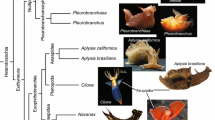Summary
Feeding behavior and the effect of its occurrence on other, unrelated behaviors were studied in the carnivorous marine gastropodPleurobranchaea calif arnica. The threshold of the feeding response is low and stable: it does not change in a circadian fashion (Fig. 1); it does not change during different behavioral states such as mating (Table 4) and quiescence (“sleep” Table 5); the threshold does not change following aversive electric shock to the oral veil (Table 1); and it does not change with repeated application of food stimuli (Fig. 2). In the present paper only two physiological variables were found to elevate the feeding response threshold; excessive mechanical stimulation (Figs. 3, 4) and satiation with food (Fig. 5).
The interaction between feeding behavior and other, unrelated behaviors was examined using a choice paradigm, i.e., simultaneous presentation of the releasing stimuli for two different behaviors. When the stimulus for feeding behavior (squid homogenate) is presented at the same time as the stimulus for righting (inversion), feeding occurs and righting is suppressed (Tables 2, 3). Similarly, feeding dominates withdrawal of the head, mating and quiescence. Neither mating nor quiescence exerts a reciprocal suppressive effect on feeding (Tables 4, 5), and hence in these cases, at least, the dominance of feeding behavior is unilateral. We conclude that behavioral acts inPleurobranchaea are organized hierarchically, and that the feeding behavior occupies a relatively dominant position in the behavioral hierarchy.
Similar content being viewed by others
References
Barton-Browne, L., Evans, D. R.: Locomotor activity of the blowfly as a function of feeding and starvation. J. Insect Physiol.4, 27–37 (1960)
Carew, T. J., Castellucoi, F., Kandel, E. R.: An analysis of dishabituation and sensitization of the gill-withdrawal reflex inAplysia. Int. J. Neuroscience2, 79–98 (1971)
Carew, T. J., Pinsker, H. M., Kandel, E. R.: Longterm habituation of a defensive withdrawal reflex inAplysia. Science175, 451–454 (1972)
Castellucci, V., Pinsker, H., Kupfermann, I., Kandel, E. R.: Neuronal mechanisms of habituation and dishabituation of the gill-withdrawal reflex inAplysia. Science167, 1745–1748 (1970)
Cook, A.: Habituation in a freshwater snail (Limnaea stagnalis). Anim. Behav.178, 463–474 (1970)
Davis, W. J., Mpitsos, G. J.: Behavioral choice and habituation in the marine molluskPleurobranchaea californica MacFarland (Gastropoda, Opisthobranchia). Z. vergl. Physiol.75, 207–232 (1971)
Davis, W. J., Mpitsos, G. J., Pinneo, J. M.: The behavioral hierarchy of the molluskPleurobranchaea. II. Hormonal suppression of feeding associated with egg-laying. J. comp. Physiol.90, 225–243
Davis, W. J., Siegler, M. V. S., Mpitsos, G. J.: Distributed neuronal oscillators and efference copy in the feeding system otPleurobranchaea. J. Neurophysiol.36, 258–274 (1973)
Frings, H., Frings, C.: Chemosensory bases of food-finding and feeding inAplysia Juliana (Mollusca, Opisthobranchia). Biol. Bull.128, 211–217 (1965)
Gardner, B. T.: Hunger and sequential responses in the hunting behavior of salticid spiders. J. comp. physiol. Psychol.58, 167–173 (1964)
Gelperin, A.: Neural control systems underlying insect feeding behavior. Amer. Zool.12, 489–496 (1972)
Hirsch, G.: Die Ernährungsbiologie fleischfressender Gastropoden. Zool. Jb. Abt. allg. Zool. u. Physiol.35, 357–504 (1915)
Jacklet, J. W.: A circadian rhythm of optic nerve impulses recorded in darkness from the isolated eye ofAplysia. Science164, 562–563 (1969)
Jacklet, J. W.: Circadian locomotor activity inAplysia. J. comp. Physiol.79, 325–341 (1972)
Jacklet, J. W., Geronimo, J.: Circadian rhythm: population of interacting neurons. Science174, 229–302 (1971)
Kupfermann, I.: A circadian locomotor rhythm inAplysia californica. Physiol. and Behav.3, 179–181 (1968)
Kupfermann, I.: Feeding behavior inAplysia: A simple system for the study of motivation. Commun. Behav. Biol. (1974) (in press)
Kupfermann, I., Castellucci, V., Pinsker, H., Kandel, E.: Neuronal correlated of habituation and dishabituation of the gill-withdrawal reflex inAplysia. Science167, 1743–1745 (1970)
Kupfermann, I., Pinsker, H.: A behavioral modification of the feeding reflex inAplysia californica. Commun. Behav. Biol.2, 13–17 (1968)
Lickey, M. E.: Effect of various photoperiods on a circadian rhythm in a single neuron. In: Invertebrate nervous systems (ed. C. A. G. Wiersma) p. 321–328. Chicago: Chicago Univ. Press 1967
Mpitsos, G. J., Davis, W. J.: Learning: classical and avoidance conditioning in the molluskPleurobranchaea. Science180, 317–320 (1973)
Peretz, B.: Habituation and dishabituation in the absence of a central nervous system. Science169, 379–381 (1970)
Pinsker, H., Kupfermann, I., Castellucci, V., Kandel, E.: Habituation and dishabituation of gill-withdrawal reflex inAplysia. Science167, 1740–1742 (1970)
Preston, R. J., Lee, R. M.: Feeding behavior inAplysia californica: Role of chemical and tactile stimuli. J. comp. physiol. Psychol.82, 368–381 (1973)
Snedecar, G. W., Coehran, W. G.: Statistical methods, sixth ed. p. 329–230. Ames: Iowa State Univ. Press 1967
Strumwasser, F.: The demonstration and manipulation of a circadian rhythm in a single neuron. In: Circadian Clocks (ed. J. Aschoff), p. 442–462. Amsterdam: North Holland Publ. Co. 1965
Strumwasser, F.: The cellular basis of behavior inAplysia. J. psyohiat. Res.8, 237–257 (1971)
Author information
Authors and Affiliations
Additional information
Supported by NIH grant NS 09050 to W. J. D. and Postdoctoral Fellowships from the Helen Hay Whitney Foundation and NIH to G. J. M.
We thank Kathryn B. Davis for technical assistance and Melody V. S. Siegler for reading the manuscript.
Rights and permissions
About this article
Cite this article
Davis, W.J., Mpitsos, G.J. & Pinneo, J.M. The behavioral hierarchy of the molluskPleurobranchaea . J. Comp. Physiol. 90, 207–224 (1974). https://doi.org/10.1007/BF00701474
Received:
Issue Date:
DOI: https://doi.org/10.1007/BF00701474




